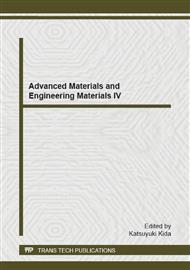[1]
ČSN 73 1002 Pile foundations, 2/1989, Date of cancellation: 1. 5. (2006).
Google Scholar
[2]
R. Cajka, J. Labudkova: Dependence of deformation of a plate on the subsoil in relation to the parameters of the 3D model, International Journal of Mechanics, Volume 8, Pages 208-215, ISSN: 1998-4448, (2014).
Google Scholar
[3]
M. Pinka, M. Stolarik, R. Fojtik, T. Petrik: Experimental Seismic Measurement on the Testing Construction and the Analyze. Transactions of the VSB - Technical University of Ostrava, Construction Series, Volume XII, Number 1/2012, VSB - TU Ostrava, ISSN 1804-4824 (Online), doi: 10. 2478/v10160-012-0006-6, (2012).
DOI: 10.2478/v10160-012-0006-6
Google Scholar
[4]
J. Kralik, M. Simonovic: Elasto-plastic analysis of deformation soil body with 3D-finite and infinite elements. International Conference Geomechanics 93, Strata Mechanics/Numerical Methods/Water Jet Cutting/Mechanical Rock Disintegration, Pages 229-232, Ostrava, Czech Republic, Sep 28-30, (1993).
DOI: 10.1016/0148-9062(95)94704-3
Google Scholar
[5]
R. Cajka, V. Buchta, K. Burkovic, R. Fojtik: Experimental Soil – Concrete Plate Interaction Test and Numerical Models. Key Engineering Materials, Vols. 577-578, (2014).
DOI: 10.4028/www.scientific.net/kem.577-578.33
Google Scholar
[6]
R. Cajka, V. Krivy, D. Sekanina: Design and Development of a Testing Device for Experimental Measurements of Foundation Slabs on the Subsoil. Transactions of the VSB - Technical University of Ostrava, Construction Series, Volume XI, Number 1/2011, VŠB TU Ostrava, ISSN 1804-4824 (Online). doi: 10. 2478/v10160-011-0002-2, (2011).
DOI: 10.2478/v10160-011-0002-2
Google Scholar
[7]
V. Buchta, P. Mynarcik: Experimental testing of fiberconcrete foundation slab model, Applied Mechanics and Materials Vols. 501-504 (2014).
DOI: 10.4028/www.scientific.net/amm.501-504.291
Google Scholar
[8]
Cajka R, Burkovic K, Buchta V. Foundation Slab in Interaction with Subsoil, Advanced Materials Research, vols. 838-841, pp.375-380 (6 p), Trans Tech Publications, Switzerland, ISSN (Online) 1662-8985, ISSN (Print) 1022-6680, DOI: 10. 4028/www. scientific. net/AMR. 838-841. 375, (2014).
DOI: 10.4028/www.scientific.net/amr.838-841.375
Google Scholar
[9]
Cajka R, Burkovic K, Buchta V, Fojtik R. Experimental soil - Concrete plate interaction test and numerical models, Key Engineering Materials, vols. 577 - 578, pp.33-36 (4 p), Trans Tech Publications, Switzerland, ISSN (Online) 1662-9795, ISSN (Print) 1013-9826, DOI: 10. 4028/www. scientific. net/KEM. 577-578. 33, (2014).
DOI: 10.4028/www.scientific.net/kem.577-578.33
Google Scholar


